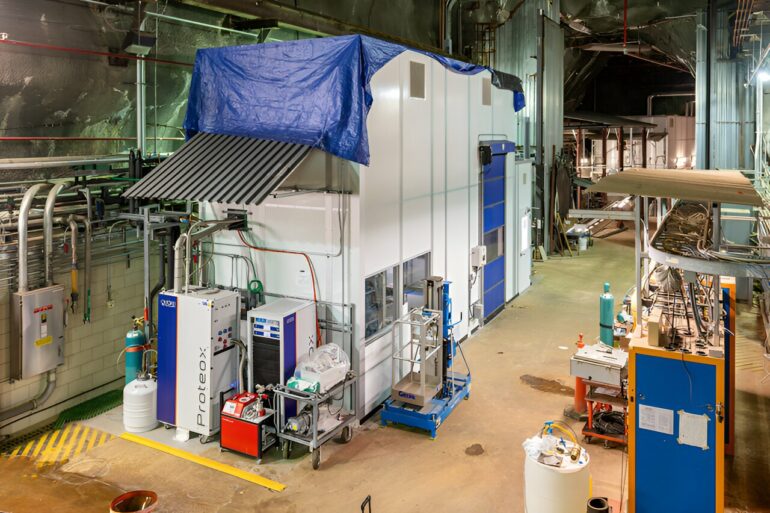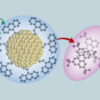Deep under the ground at Fermi National Accelerator Laboratory is a brand-new quantum sensor and computing research center called QUIET, and at the surface—100 meters above—sits its twin called LOUD.
The quantum research infrastructure is among the first of its kind to be operational in the United States. Together, QUIET and LOUD will allow for controlled experiments with quantum sensors to make direct comparisons between an environment with significantly reduced cosmic ray interference and the ambient environment on Earth’s surface.
Quantum information stored in qubits is fragile: Interactions from the environment cause the quantum states to decohere and eventually collapse into a single state. Because superconducting qubits are negatively impacted by cosmic rays and associated energetic particles like muons, understanding how this impacts these delicate devices is crucial.
The knowledge gained could enable researchers to better manipulate and protect quantum states and even contribute to a further range of applications, including the detection of dark matter.
High-energy particles impact superconducting qubits
“It’s not a surprise that when one of these very energetic particles—an X-ray, a gamma ray, or another kind of cosmic ray—hits your qubit, it wipes out all the information,” said Fermilab scientist Aaron Chou, who leads the Quantum Devices and Sensors for Discovery Science thrust of the Quantum Science Center, headquartered at the Department of Energy’s Oak Ridge National Laboratory. Fermilab is a founding partner of the QSC.
The information on a quantum chip can be destroyed within a fraction of a second due to this interference, resulting in the qubits losing information. This will appreciably limit large-scale calculations in quantum computers, according to Fermilab scientist and QSC member Daniel Baxter.
“It isn’t a problem yet, but we will see it in the future,” Baxter said. “The goal is to resolve it before we get there, because we know it’s going to be a limiting factor. If we solve it ahead of time, we will clear the runway for ourselves as we take the path towards quantum computing.”
One goal of QUIET is to understand the difference between the impact of gamma rays, X-rays, muons, and beta particles on superconducting qubits.
There are big differences in how those particles interact in a material. For example, a beta particle will interact with the atoms on the surface of a material, while a muon will pass through, depositing energy over a longer distance and deeper into the material. However, little is currently known about the nuances of how those particles interact with superconducting qubits.
Utilizing QUIET to understand the impact of high-energy stray particles on superconducting qubits could allow researchers to construct new models that are less sensitive to radiation.
This research involves taking qubits that have been tested at the surface and then moving them underground—where the muon and cosmic ray flux is much smaller—to determine how their performance changes. Potential new models could work one of two ways: researchers could either focus on shielding qubits from the interference, or design devices that are not sensitive to it in the first place.
Dark matter applications
Alternatively, using qubits as sensors for making new detectors that are hypersensitive to radiation could also be useful for the detection of dark matter.
Currently, dark matter detection is limited by most techniques sensitive only above the electron volt scale, which represents the energy gained when an electron charge is accelerated through a potential difference of one volt. These new hypersensitive quantum sensors that could detect below the eV scale may allow scientists to test a wider suite of theoretical models for dark matter.
“A more sensitive detector using superconducting qubits, which can go by a factor of more than a thousand below the eV scale, will allow us to detect energy deposits that are much smaller than what is possible in current dark matter experiments,” Chou said.
“This will allow us to detect dark matter of lower mass because it’s easier to detect that you’ve been hit with a freight train than a ping pong ball.”
Deep underground
QUIET was constructed as part of the National Quantum Initiative. The underground space it uses was originally created by Fermilab for its neutrino experiments. Neutrino beamlines are safe to be in when the beams are on, and the space provided can be used for other experiments.
“Underground facilities are quite a rare and unique thing that Fermilab has, and Fermilab is taking advantage of this underground space for cutting-edge science,” Baxter said. The convenience of QUIET is also notable in comparison to other underground spaces.
“If I’m sitting in my office, I can be underground in 10 minutes,” Baxter added.
Quantum and dark matter scientists around the world are planning similar underground quantum testing facilities in deep mines. For example, scientists with Fermilab’s Superconducting Quantum Materials and Systems Center have started testing qubits in the laboratory built beneath Gran Sasso mountain in Italy. While QUIET is not as deep, it’s accessibility provides a great advantage.
Additionally, other national laboratories have underground spaces. QUIET provides a 99% reduction in muon flux and gives scientists the opportunity to take advantage of this easily accessible underground resource for cutting edge science.
The future of QUIET
QUIET—which took two and a half years to build—is currently in its commissioning phase and should be operational in the next few months. Scientists have installed and tested a dilution refrigerator, which is necessary for the deployment of superconducting qubits. They are also setting up radio frequency electronics, which superconducting qubits use to control and read out their quantum states.
Many of the individual components of the research space, such as the fridge and electronics, are commercial items that were purchased for both QUIET and LOUD to provide direct one-to-one comparisons.
“It took a significant amount of work behind the scenes to make QUIET’s debut,” said QSC Director Travis Humble. “These efforts included installing dedicated chilled water and electrical power to a newly constructed clean room, among other infrastructure development.”
“This is a really exciting and fast-moving field, with new research constantly coming out and changing the discussion, and it’s exciting that Fermilab is one of the main players in such a relevant and high-stakes subject,” Baxter said.
Provided by
Fermi National Accelerator Laboratory
Citation:
QUIET: A place to study qubits shielded from the effects of cosmic rays (2024, June 7)



